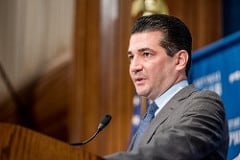As 2019 gets under way, the pharma industry and the US FDA can look back at a truly record-breaking 2018 for new drug approvals.
The final tally for novel drug approved at the US regulator last year stands at 59 new molecular entities as of 27 December – smashing all previous records.
The FDA approved 46 drugs in 2017, which had itself matched a 2015 record, but last year saw a further surge in new approvals in new chemical entities and new biologic drugs, driven on by new pharma and biotech science, and the FDA’s determination to accelerate its review times.
Far more important than the overall quantity of approvals however is the quality of the new drugs, according to FDA Commissioner Scott Gottlieb, who said in speech as the year drew to a close that “some of [the] previous records were set in years when there were a lot of drugs that critics bemoaned were me-too medicines – novel chemical entities that all addressed the same common, therapeutic targets.”

FDA Commissioner Scott Gottlieb
“The kinds of innovation we’re seeing now are more targeted, more fashioned against significant medical needs, and far more effective,” he added. Well over half of the new approvals were for rare diseases, helped by an FDA drive to eliminate a backlog in orphan drug reviews that kicked off with the Orphan Drug Modernisation Plan (ODMP) in 2017.
While the traditional flurry of approvals at the end of the year has not been evident in the last couple of years, the US agency did approve three new products in the week before the holiday period set in.
That included Alexion’s Ultomiris (ravulizumab) for paroxysmal nocturnal hemoglobinuria (PNH), a rare and life-threatening blood disease, which according to the FDA will “change the way that patients with PNH are treated.” Ultomiris need only be dosed every eight weeks, while current drugs for PNH have to be given every two weeks.
The last few days of the year also saw approvals for Stemline Therapeutics’ Elzonris (tagraxofusp) – the first drug to be licensed for rare cancer blastic plasmacytoid dendritic cell neoplasm (BPDCN) – and Servier’s Asparlas (calaspargase pegol), a long-acting drug for acute lymphoblastic leukaemia that also extends the dosing interval for patients.
Other highlights of the year included Alnylam’s hereditary ATTR amyloidosis drug Onpattro (patisiran) becaming the first RNA interference (RNAi) therapy to get a green light from the FDA.
There were also a slew of new drugs that were the first therapies to be approved by the FDA to treat diseases, including Catalyst Pharma’s Firdapse (amifampridine) for Lambert-Eaton myasthenic syndrome (LEMS), Novimmune’s Gamifant (emapalumab) for primary hemophagocytic lymphohistiocytosis (HLH), Regeneron/Sanofi’s Libtayo (cemiplimab) for cutaneous squamous cell carcinoma (CSCC), and SIGA Technologies’ TPOXX (tecovirimat) for smallpox.
There were also a number of drugs with brand new mechanisms of action, including three CGRP inhibitors for migraine prevention from Amgen, Teva and Eli Lilly – as well as Agios Pharma’s IDH1 inhibitor Tibsovo (ivosidenib) for acute myeloid leukaemia (AML), AstraZeneca’s CD22-directed cytotoxin Lumoxiti (moxetumomab pasudotox) for hairy cell leukaemia (HCL), and TaiMed Biologics’ CD4-binding antibody Trogarzo (ibalizumab) for resistant HIV infections.
Also worth a mention is Lox/Bayer’s Vitrakvi (larotrectinib), which became the second drug to be approved based on a biomarker across different types of tumours rather than the location in the body where the tumour originated (after Merck & Co’s Keytruda), and GW Pharma’s epilepsy therapy Epidiolex (cannabidiol) which is the first FDA-approved drug based on cannabis.
Approval of ‘tissue agnostic’ cancer therapies based on biomarkers is expected to be an emerging trend in the coming years, while a relaxation of the regulations surrounding cannabis for medical uses is opening up what some analysts predict will be a multibillion dollar market.
However the record number of approvals isn’t the whole story, with the flipside being that the industry is getting far lower average returns from its drug launches than ever before. A study published in December by Deloitte showed that R&D costs have doubled in eight years, while peak sales forecasts have halved.
Gottlieb has also highlighted the importance of new generic and biosimilar approvals in the US, especially within the context of pricing and competition. The FDA Commissioner recently reiterated his criticism of anti-competitive measures from originator companies which block biosimilars. He has promised to do more to speed approval and access to these cut-price copies of big-selling biologics in 2019, as well as pursuing measures for innovative medicines, such as developing regulatory pathways for cell and gene therapies.
Analysts expect 2019 to see industry filings around the same level as 2018, although whether it can match or exceed last year’s tally is hard to predict. In the political arena, the US will face some titanic battles over healthcare reform this year, with the Democrats taking control of the House of Representatives, and opposing moves by the Republicans to dismantle the Affordable Care Act.
However this won’t have a direct impact on approvals in 2019, with the question of how far Gottlieb can go in further accelerating approvals while maintaining standards being the key question for the US regulator.
One political spat which could cause a lag in approvals in 2019 is the ongoing government shutdown, brought about by President Trump’s demands for $5bn in funding for his border wall, and refusal from Democrats to approve its financing. The FDA was among a number of government agencies which began a partial shutdown just ahead of Christmas, with operations likely to be affected if the shutdown drags on without resolution.




